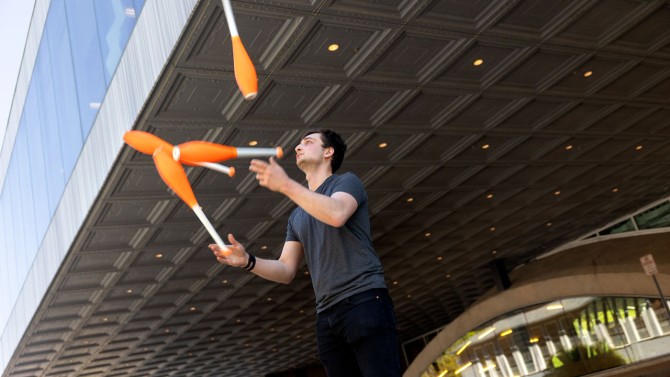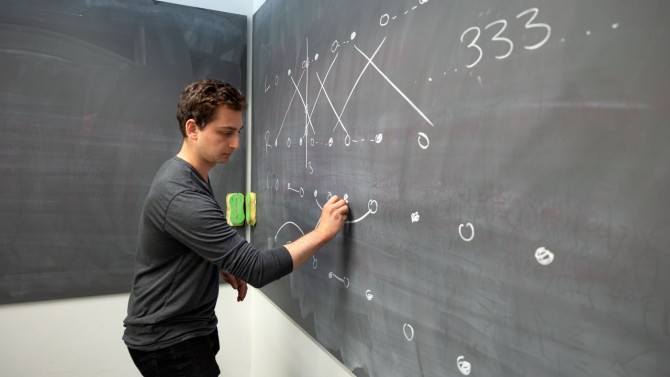Jonah Botvinick-Greenhouse, a doctoral student in applied math, is a contender to win the World Juggling Federation’s first Ultimate Overall Championship on June 30 in Paris, a platform the WJF is using to build a case for juggling as an Olympic sport. ESPN will broadcast the event Aug. 2.
Going for Paris gold, math scholar aids juggling’s Olympic bid
By James Dean, Cornell Chronicle
Outside Gates Hall as spring classes ended, Jonah Botvinick-Greenhouse juggled a flurry of white balls – five, if you could keep track – hands occasionally crisscrossing, at times juggling entirely behind his back or above his head. Suddenly launching several balls skyward, the doctoral student in applied math pirouetted twice before calmly receiving the plummeting projectiles and lofting them back to lower altitudes.
“Wow,” said a passing student, taking out a phone to record the scene. “Cool,” remarked another. “That’s dope,” agreed a third, pausing mid-jog. Others wandered by, too distracted to notice one of the world’s best jugglers at work.
On June 30, Botvinick-Greenhouse, a two-time winner of the World Juggling Federation’s Advanced Overall Championship, will compete in Paris for the WJF’s first Ultimate Overall Championship, pitting him against three other past champions from the U.S., Germany and Norway.
The Paris Olympic Committee invited the WJF to host the competition and an annual convention as part of pre-Summer Games festivities – a platform the WJF is using to build a case for juggling as an Olympic sport. Federation President Jason Garfield said Botvinick-Greenhouse, who holds a host of world records (here’s one), has a shot to take gold in the event featuring routines with balls, rings and clubs, which ESPN will broadcast on Aug. 2.
“His patterns, his control, his symmetry and his accuracy I think are unparalleled,” Garfield said. “Jonah’s juggling is very aesthetically pleasing. It’s rare, and I would say comforting, but also inspiring – and almost not believable, because it looks like it was programmed, like it’s a simulation.”
Perhaps that’s appropriate for someone whose research in the Center for Applied Mathematics focuses on dynamical systems, and who as an undergraduate co-authored an article called “Juggling Dynamics” in Physics Today. Botvinick-Greenhouse, who earned math and physics degrees at Amherst College, not only takes pleasure in the act of juggling, but in the math underlying its patterns and the numerical notation system used to describe them, called “siteswap.”
“It turns out there are a lot of exciting connections between mathematics and juggling, so many people who happen to like math will take to juggling pretty easily,” he said. “It’s kind of the go-to language for how jugglers talk to each other and communicate about the tricks that they’re doing.”
Earlier this year, he led a Math Explorers’ Club workshop on the math of juggling that posed the questions: How are humans capable of performing juggling patterns that exceed the limits of standard reaction times? Why can four balls not be juggled in a crossing pattern? What kinds of mistakes in a juggling pattern will cause the juggler to drop?
It also introduced siteswap, a mathematical abstraction developed in the mid-1980s that counts the number of beats until an object is manipulated again – a number roughly corresponding to its throw height – and the order in which objects are swapped between hands. Thus, a standard three-ball cascade, among the first patterns learned, in which each ball is tossed every third throw, is denoted as “3” (or “333…”). Another common pattern, the three-ball shower, becomes “51” (or “515151…”): The right hand throws balls higher (5) to the left hand, which zips them back across to the right hand (1).
Jugglers can analyze siteswaps to determine if a pattern can be juggled. For example, since averaging a siteswap’s digits reveals the number of objects being juggled, the average cannot be a fraction.

Cornell Juggling Club members practice with clubs during a weekly gathering in the Physical Sciences Building atrium. Jonah Botvinick-Greenhouse, second from left, and Bennett Santora ’26, far right, both have won elite juggling competitions.
Allen Knutson, a math professor in the College of Arts and Sciences who once held a world record – 68 catches of 12 balls with a partner – said jugglers can read siteswaps to confirm two essential conditions: that no two objects will land at the same time, and that an object will always be available to throw. Validate one condition and the other follows – a mathematical statement, said Knutson, who regularly gives talks on the math of juggling with demonstrations (including once juggling two balls while shifting his infant son from arm to arm).
“If you boil something down sufficiently, then it will become mathematics,” Knutson said. “Things sufficiently well understood can’t help but become mathematics.”
Bennett Santora ’26, an information science major and former International Jugglers’ Association junior gold medalist – yes, the Big Red is having a moment with two world-class student jugglers – wrote a college admissions essay about siteswap, which enables jugglers to assess patterns’ difficulty and unlocked previously unknown patterns.
“It made this technical progression of juggling possible,” said Santora, who can juggle seven balls consistently and has juggled as many as nine. “When everything was just kind of vaudeville tricks, it wasn’t obvious what the next hardest thing in the progression was. Now it’s just a question of, can you do it?”
For Botvinick-Greenhouse, more than most, the answer is yes.
Introduced to juggling by a friend when he was 10, he adopted YouTube as his mentor. Hours of daily practice ensued, and he won a WJF junior title at age 12, just two years before claiming his first advanced overall championship – the youngest to do so. His progression is documented on a YouTube channel and Instagram feed.
One key to his success: a willingness to fail repeatedly before achieving a goal. (Also: parents willing to endure the constant clatter of clubs hitting the living room floor.)
“I’m not surprised that I’m the kind of person who enjoyed learning to juggle four or five balls when I was 10 and 11, and now I’m doing math research,” said Botvinick-Greenhouse, also an advanced cellist who plays in a campus quartet. “It seems like a similar thing going on in the brain that enjoys that type of progression. You’re not going to find the solution to a research question right away, and it’s going to take a lot of persistence and failing over and over again, but you enjoy the process of trying to work up to it.”
While prioritizing his Ph.D. program responsibilities, Botvinick-Greenhouse in recent years has taken his practice to high-ceilinged venues across campus – from Barton and Statler halls to squash courts and the Physical Sciences Building atrium, where the Cornell Juggling Club meets weekly. Even when he couldn’t put in his current one or two hours of training a day, at least five days a week, he took refuge in juggling as a stress-relieving hobby.
“Juggling can take you out of whatever you might be thinking about that day and transport you to this world where all you can think about is the juggling, because it requires so much focus,” he said.
And, though it may be underestimated by casual observers, athleticism – the strength, dexterity, hand-eye coordination, precision and composure to juggle many objects at once for extended periods, which can quickly become tiring and allows almost no room for error.
“One small mistake,” Botvinick-Greenhouse said, “everything hits the ground.”
At Le Carreau du Temple in Paris, he expects to perform routines including 360s and 720s, “overheads” and “backcrosses” – as demonstrated outside Gates Hall – plus ring combinations of “pancakes”; throwing as many as five clubs rotating at different rates; and various moves with only siteswap names, like a 97531, which builds a tower of balls caught in reverse order.
As in figure skating or gymnastics, whose scoring systems the WJF’s mimics, sport jugglers must balance ambitions to perform very difficult, high-scoring moves with the risk of errors that would earn deductions – ranging from collisions and drops to asymmetrical patterns, moving one’s feet too much, bad posture or other poor form.
Botvinick-Greenhouse imagines his 10-year-old self would be thrilled to know he might play a prominent role in sport juggling’s ascent to an Olympic stage. Though he now possesses a deeper appreciation for the math and dynamics of juggling, he said that’s not what ultimately will propel him to a podium in Paris, or perhaps Los Angeles in 2028 or Brisbane in 2032.
“There’s less crossover than you would hope between the theory and practice of it,” he said. “It’s fun to think about mathematically and physically, but at the end of the day, the only thing that can help me improve and do good routines is practice. Just look up, and juggle.”
Media Contact
Get Cornell news delivered right to your inbox.
Subscribe


